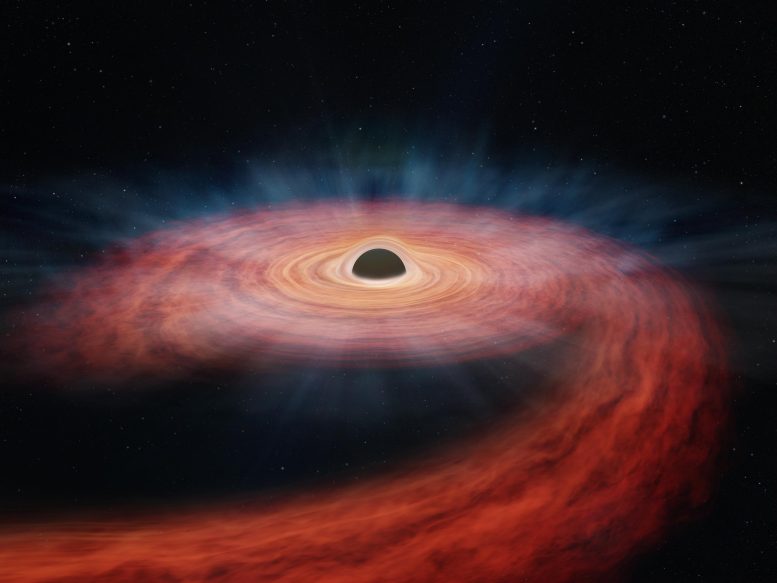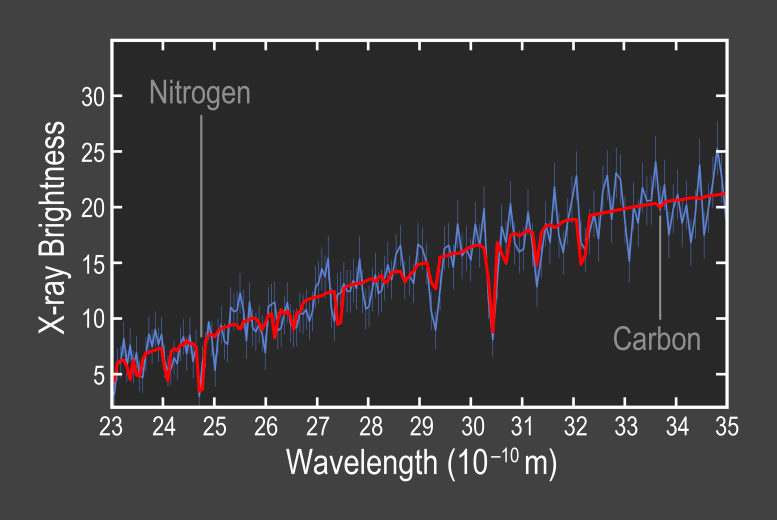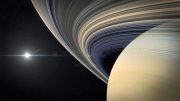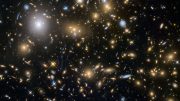
This artist’s illustration depicts the aftermath of the “tidal disruption event” (TDE) called ASASSN-14li, where a star was shredded after approaching too closely to a supermassive black hole. After the star was ripped apart, some of its gas (red) orbited around and fell into the black hole, while a portion of the gas was driven away in a wind (blue). Credit: NASA/CXC/Univ of Michigan/J. Miller et al.; Illustration: NASA/CXC/M.Weiss
- A giant black hole 290 million light-years away destroyed a large star and threw its pieces into space.
- NASA’s Chandra X-ray Observatory and ESA’s XMM-Newton scoured the wake of this event for information.
- The X-ray data reveals the relative amount of nitrogen compared to carbon in this stellar debris field.
- Comparison with models shows that a star with three times the mass of the Sun was destroyed, making it one of the largest known “tidal disruption events.”
Using NASA’s Chandra X-ray Observatory, ESA’s XMM-Newton, and other telescopes, astronomers have determined that a giant black hole has destroyed a large star and strewn its contents into space. By analyzing the details of the X-ray data, the team were able to estimate the relative amount of nitrogen compared to carbon in the aftermath of this gravitational assault. These elements provide valuable clues to the researchers for what type of star met its demise.
Artistic Representation of the Event
An artist’s illustration (at the top of this article) brings to life the “tidal disruption event” (TDE) called ASASSN-14li, which is the focus of the latest study. As a star approached too closely to the supermassive black hole in the system, the strong gravity tore the star apart. This artist’s impression depicts the aftermath of this destruction. After the star was ripped apart, some of its gas (red) was left orbiting around and falling into the black hole. A portion of the gas was driven away in a wind (blue).
Analyzing the Elements
Scientists used an X-ray spectrum — that is, a plot of X-ray brightness compared to wavelength — from Chandra and XMM to probe the elements contained in this wind. The Chandra spectrum is shown in the inset, where the data is colored blue (jagged lines) and the uncertainties for each data point are blue vertical lines. A model of the spectrum is given in red, highlighting the detection of nitrogen from the dip in the spectrum, and the non-detection of carbon from the lack of a dip.

X-ray Spectrum, Chandra. Credit: NASA/CXC/Univ of Michigan/J. Miller et al.; Illustration: NASA/CXC/M.Weiss
The amount of nitrogen and the maximum amount of carbon that could escape detection provides a minimum value for the ratio of nitrogen to carbon that agrees with the data. This value indicates that the shredded star in ASASSN-14li was about three times the mass of the Sun. This would make it one of the largest stars ever known to be devastated in a TDE.
Historical Context and Future Implications
ASASSN-14li was first discovered in November 2014 by ground-based telescopes, when it was realized that this was the closest TDE to Earth in about a decade. In the years since, many telescopes, including Chandra, have observed this system.
In addition to the unusual size of the destroyed star and the ability to conduct detailed forensics on it, ASASSN-14li is also exciting because of what it means for future studies. Astronomers have seen moderately massive stars like ASASSN-14li’s in the star cluster containing the supermassive black hole in the center of our galaxy. Therefore, the ability to estimate stellar masses of tidally disrupted stars potentially gives astronomers a way to identify the presence of star clusters around supermassive black holes in more distant galaxies.
Until this study, there was a strong possibility that the elements observed in X-rays might have come from gas released in previous eruptions from the supermassive black hole. The pattern of elements analyzed here, however, appears to have come from a single star.
Reference: “Evidence of a Massive Stellar Disruption in the X-Ray Spectrum of ASASSN-14li” by Jon M. Miller, Brenna Mockler, Enrico Ramirez-Ruiz, Paul A. Draghis, Jeremy J. Drake, John Raymond, Mark T. Reynolds, Xin Xiang, Sol Bin Yun and Abderahmen Zoghbi, 21 August 2023, The Astrophysical Journal Letters.
DOI: 10.3847/2041-8213/ace03c
A paper describing these results has been published in The Astrophysical Journal Letters. The authors are Jon M. Miller (University of Michigan, Ann Arbor), Brenna Mockler (Carnegie Observatories), Enrico Ramirez-Ruiz (University of California, Santa Cruz), Paul Draghis (University of Michigan), Jeremy Drake (Center for Astrophysics | Harvard & Smithsonian), John Raymond (CfA), Mark Reynolds (University of Michigan), Xin Xiang (University of Michigan), Sol Bin Yun (University of Michigan), and Abderahmen Zoghbi (University of Maryland).
NASA’s Marshall Space Flight Center manages the Chandra program. The Smithsonian Astrophysical Observatory’s Chandra X-ray Center controls science operations from Cambridge, Massachusetts, and flight operations from Burlington, Massachusetts.









Be the first to comment on "Mysterious ASASSN-14li: Massive Star Obliterated by a Giant Black Hole"